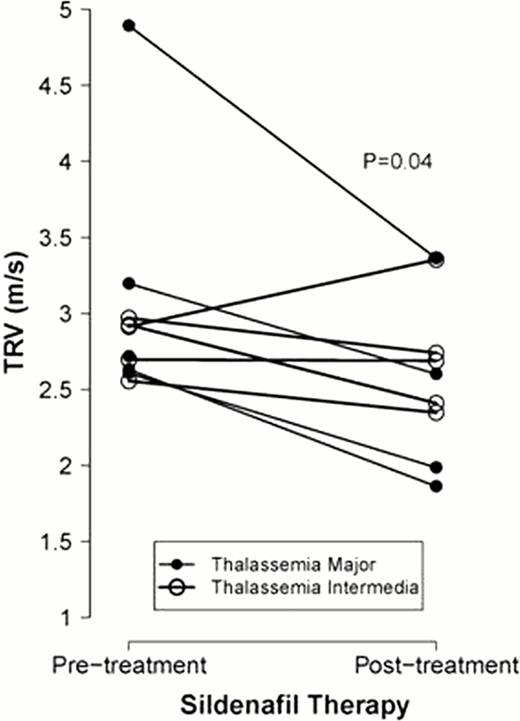Abstract
Abstract 1023
Pulmonary hypertension (PH) is a complication associated with thalassemia syndromes, particularly thalassemia intermedia. There are limited data on the safety and efficacy of selective pulmonary vasodilators in this at-risk population.
We evaluated the safety and efficacy of a 12-week prospective, phase 1/2 pilot scale study of sildenafil (100 mg TID) in ten b-thalassemia patients with elevated TRV on Doppler-echocardiography ≥ 2.5 m/s suggestive of PH risk. Patients were evaluated at baseline and at weeks 2, 4, 8 and 12 of sildenafil therapy, and six minute walk distance (6MWD), biomarkers of hemolysis, coagulation, inflammation and adhesion were assessed.
Our study population had an average age of 37±12.3 years, 8/10 were male, and 50% were thalassemia intermedia. Splenectomy prevalence was high (90%), and only 30% of patients were transfused since infancy. The mean pre-transfusion hemoglobin was 10.4±1.5 g/dL. A 12-week open-label trial resulted in a significant decrease in TRV by 13.3% (3.0±0.7 vs. 2.6±0.5m/s, p=0.04, Figure 1), improvements in left ventricular end systolic/diastolic volume (p≤0.02), diffusion capacity for carbon monoxide (DLCO, p=0.003) and a trend towards a reduced Borg Dyspnea Score and improved NYHA Functional class. No significant change in 6MWD was noted, although 6MWD correlated strongly with DLCO (ρ=0.72, p=0.03) suggesting that oxygen diffusion across the alveolar-capillary membrane was an important determinant of exercise capacity. Sildenafil was generally well tolerated, but most patients experienced anticipated transient headaches and visual/color disturbances associated with sildenafil use. One patient withdrew from the study due to worsening dyspnea. No other serious adverse events were reported. A strong direct correlation between total dose of sildenafil (mg) taken and % change in plasma NO metabolite concentration was observed (ρ =0.80, p=0.01). A significant increase in plasma and erythrocyte arginine concentration occurred, without an associated change in plasma arginase activity/concentration, nitric oxide metabolites or vascular endothelial growth factor. However arginase concentration was elevated in this cohort similar to prior reports, and correlated inversely to hemoglobin (ρ=-0.41, p=0.01), and directly to ALT (ρ=0.40, p=0.004), AST (ρ=0.38, p=0.04), left ventricular end systolic volume (ρ=0.77, p=0.001), and end-diastolic volume (ρ=0.79, p=0.001).
Our study suggests that sildenafil is safe and may improve cardiopulmonary hemodynamics in patients at risk for PH, however improved exercise capacity as reflected by an improved 6MWD was not observed. The reduction in left ventricular dimensions is promising, and could reflective of either increased inotropy or chronotropy, or decreased systemic afterload. This is also the first report of an influence of sildenafil on diffusion capacity of the lungs in patients with thalassemia and the first description of increased plasma and erythrocyte arginine concentration after sildenafil therapy. Given the association of arginine bioavailability with long-term survival in cardiovascular disease, this is an unexpected effect of sildenafil that warrants further investigation. These data support the need for further clinical trials evaluating the use of sildenafil in thalassemia.
Taher:Novartis: Research Funding, Speakers Bureau.
Author notes
Asterisk with author names denotes non-ASH members.


